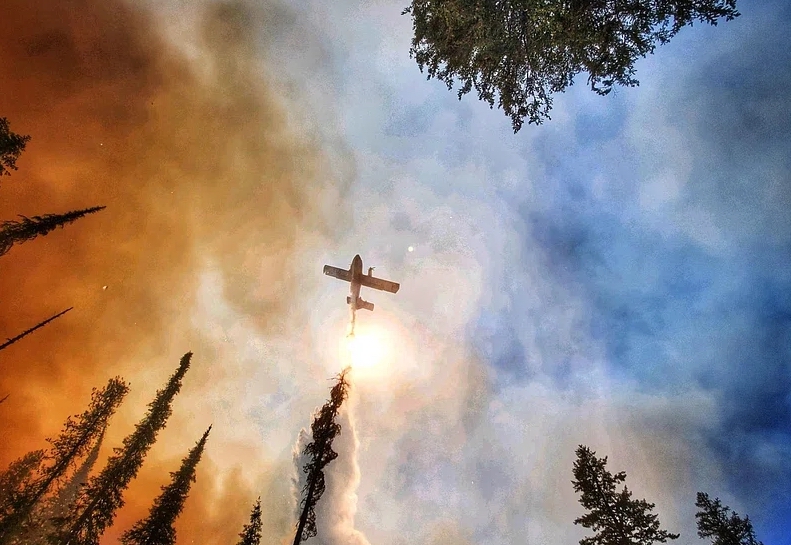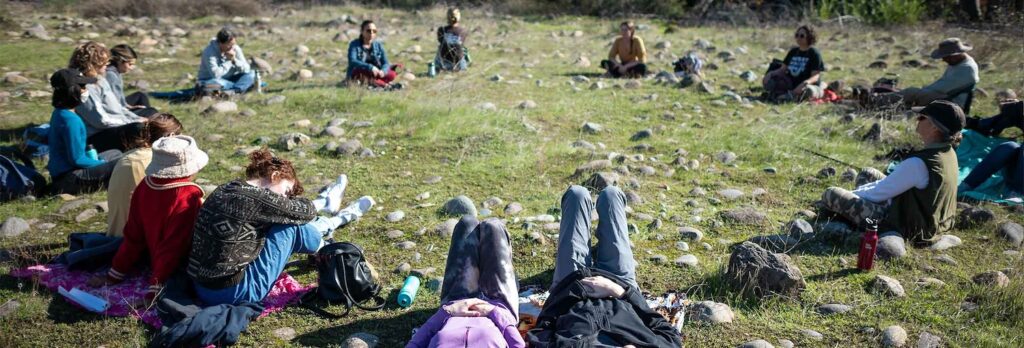Blake Ellis had just left her Chico, California, home for work the morning of November 8, 2018, when she saw a plume of smoke rising in the east. A few hours earlier, a high voltage powerline nearby broke, arced lightning down a transmission tower, and rained molten metal onto the dry brush below, starting a fire that raced through the hills.
Ellis quickly checked on everyone she knew who lived nearby before packing her pets into her car and evacuating to a friend’s ranch further from the flames. Authorities had deemed Chico safe, but anything seemed possible.
By the time the blaze—known now as the Camp Fire—was extinguished, it ravaged 150,000 acres, razed 19,000 buildings, and took 85 lives in what remains the deadliest and most destructive wildfire in California’s history.

Megafires like this can easily destroy a community’s sense of home, even for those like Ellis, who escaped with homes, belongings, and loved ones untouched. But the charred remains become a landscape of grief, what Australian philosopher Glenn Brecht, in 2005, called “solastalgia,” a specific flavor of heartbreak that accompanies the devastating loss or transformation of one’s homelands.
“It is the mental, emotional, and spiritual pain you feel when your beloved place or home environment has been transformed beyond recognition,” said Ellis. This is the kind of pain she’s been helping her community—and herself—understand, accept, and heal since the Camp Fire.
In its immediate aftermath, Ellis supported local mutual aid efforts, but she felt called to deepen her capacity to serve her community as they recovered from the disaster. In the following months, Ellis enrolled in Chico State’s social work master’s program and joined AmeriCorps as a disaster case manager to work with those affected by the fire.
Across conversations with her clients, Ellis tracked a pattern of anguish and grief that went beyond lost homes or lost belongings. “It was really this loss of place,” she said. “It was this loss of one’s home environment. It was the loss of the trees. It was the loss of the wildlife running through their yard, the loss of a landscape that they knew and felt deeply connected to.”
She explored this ecological sorrow in her master’s thesis, continuing to ask the question: How do you heal that kind of overwhelming grief?
Now, she’s dedicated her entire career to it.
Forest Bathing Becomes Forest Therapy
During her studies, Ellis learned of forest therapy, and the idea possessed her. Forest therapy is based on the simple premise that mindful time in nature can itself be healing.
The idea takes inspiration from the Japanese practice of shinrin-yoku, or “forest bathing,” first proposed in 1982, under the belief that experiencing nature with the totality of one’s senses could reduce stress, ease overstimulation, and improve health—benefits that have been backed by study after study.
After learning about forest bathing in the early 2010s, counselor, former Buddhist, and wilderness guide Amos Clifford decided to weave together the science of shinrin-yoku with his professional experience and develop his own brand of forest therapy. His goal reached beyond personal health to focus on addressing a concern he holds for humanity.
“We have a collective amnesia about our relationship with the more-than-human world,” Clifford said. He found that short guided nature walks could offer an accessible, low-cost way to begin restoring those vital relationships.

In 2012, Clifford founded the Association of Nature and Forest Therapy, formalized his approach, and two years later, trained the first group of forest therapy guides. The popularity of forest therapy and forest bathing has grown steadily ever since, with bestselling books such as Dr. Qing Li’s Forest Bathing (2018) further propelling such practices into the mainstream.
The practice has gained such broad acceptance that, in October 2025, the World Forum on Forest Therapy will convene in South Korea to bring together a diverse pool of researchers and practitioners to exchange ideas and best practices.
The breadth of its popularity should come as no surprise given concepts loosely related to shinrin-yoku have long existed around the world, like Norway’s friluftsliv, or “open-air living,” and Sweden’s allemansrätten, or “right to roam.”
Forest Therapy, Certified
In October 2019, following the Camp Fire, Eli Goodsell, executive director for Chico State University’s Big Chico Creek Ecological Reserve, won grant funding to train and certify 15 locals as forest therapy guides through Clifford’s association. The guides went on to lead forest walks for those still coping with trauma from the Camp Fire. Ellis was one of these trainees.
“We have a collective amnesia about our relationship with the more-than-human world.”
Before the process began, however, COVID spread, and Clifford’s team had to redesign their training to accommodate lockdown, delaying the program a measure.
In July 2021, all the guides were officially certified, and the first public walks commenced. Despite pandemic restrictions, they served almost 400 community members in their first two months. That fall, the Ecological Reserve partnered with on-campus counseling to create the Chico State Ecotherapy Program, which Ellis was hired to manage.
In the years since, the program has supported hundreds of students and community members through dozens of events every year. Each therapeutic walk follows what Clifford calls the “standard sequence.” First, participants are invited to tune into the present and engage with their senses. Second, as the group strolls about, guides ask participants to interact with the landscape. Sometimes this can be as simple as noticing what’s in motion, or dipping their feet in a creek.
RELATED: Yurok Tribe Celebrates Largest Land Back Deal in California History
After each exercise, guides offer everyone a chance to share, or not, what they’re feeling and experiencing. To close the walks, guides will often brew tea—often using locally foraged ingredients—to share with the participants before they depart.
For survivors of wildfire, these guided walks afford an opportunity to heal the fractured relationship between them and the land. In areas affected by fire, those who returned might be invited to approach the burned trunk of a tree and bid farewell in final communion.
But interacting with a devastated place need not always be mournful. Ellis recalled the potency of taking survivors to a burn scar and allowing them to reflect on what they saw, experienced, and felt. Many shared how nature’s regeneration reflected their own internal recovery.
“These transformed landscapes don’t have to be just the source of our pain,” Ellis said. “We can relearn and reconnect with that landscape, and hopefully even develop a healthier relationship than we had with that landscape to begin with.”
Repairing the relationships between people and the natural world is central not only to Ellis, but it also undergirds the land-based healing that Indigenous peoples have practiced for millennia.
Forest Therapy Goes Beyond Recovery
When Victoria, Australia, suffered devastating wildfires in 2009, researchers studied communities recovering over the span of several years.
While their initial interests focused on the role of social networks in supporting resilience, their interviews revealed that people’s connection with the environment carried an importance of its own. People with deeper connections to nature experienced less distress, depression, and PTSD. They also demonstrated more resilience, life satisfaction, and personal growth after the fire.
“These transformed landscapes don’t have to be just the source of our pain,” Ellis said. “We can relearn and reconnect with that landscape, and hopefully even develop a healthier relationship than we had with that landscape to begin with.”
Other studies have drawn similar conclusions. In Houston, after Hurricane Harvey in 2017, people living in neighborhoods with access to green space exhibited less PTSD than those who didn’t. A similar trend emerged following Hurricane Sandy, which swamped New York City, where community gardens emerged as sites of local resilience for those who visited them.
For Ellis, forest therapy derives a large part of its power from its communal character. As she sees it, wildfires leave behind a collective grief that demands collective healing, which small-group forest therapy is designed to provide. The importance of this will only grow as climate-related disasters deepen.

Already, over the last fifty years, climate change has multiplied the annual area burned by fire in California, fivefold, and as summers grow yet warmer and forests get yet drier, these fires will spread faster in California and beyond.
Most other climate-accelerated disasters will worsen, too, inflicting additional trauma on communities. Forest therapy may then be an increasingly reliable tool available to help communities prepare for and respond to the emotional toll that accompanies such tragedies.
Looking Ahead
Seven years have passed since the Camp Fire, and Chico State’s ecotherapy program continues to be a vital resource for Butte County, especially after last year’s Park Fire burned nearly 430,000 acres across the county and its northern neighbor.
Though funding constraints have caused them to pause their large public events, Ellis and her team are now working directly with organizations to serve a mix of professionals, students, and educators. Ellis remains adamant about the importance of this service.
For her, as for Clifford, it addresses a fundamental challenge: the frayed relations between humanity and the environment. Nature and forest therapy represents “one way that we can both tend to people’s mental health in a community-oriented fashion, and start to shift and repair those relationships.,” Ellis said. “The climate crisis is a relational crisis.”
